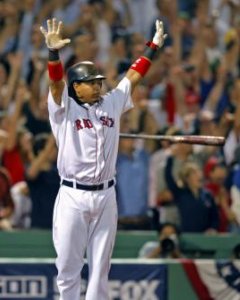Well, you certainly cannot look back on the first half of the season and wonder if it would have been the Yankees that were seven games back at the break and thinking wild card had the Red Sox had the lineup that was drawn on paper by Theo Epstein during the off-season. However, even as it stands, Boston enjoyed what, for many teams, would have been a successful first half: ten games above .500 and poised to make a run at a playoff spot in October. There are 76 games left to play in the 2004 season; as we enjoy the All-Star break, we look back on the studs and duds of the first 86 games.
Team MVP: Manny Ramirez
First runner-up: Curt Schilling
Even though this is his fourth season in Boston, it almost seems like we are meeting Ramirez for the first time, and the faithful are enjoying his company. The suddenly easygoing left fielder is enjoying a banner year: his .344 batting average, 26 home runs, and 77 RBI are tops on his team and have him at or near the top of the American League leader board. Not only is he a legitimate AL MVP at this point, he has a chance to become the first batting Triple Crown winner in nearly forty years. It’s hard to imagine that he was nearly sent packing over the winter; never have the cheers been louder when he comes to the plate or he makes a sensational catch in left field.
Team Goat: Derek Lowe
First runner-up: Kevin Millar
Perhaps he feels that he is being picked on, but Lowe has certainly not carried himself well enough on the field to be worthy of a multiyear deal that his agent, Scott Boras, is looking to get him this off-season in the $11 million per year range. His ERA of 5.57 is one and a half runs per nine innings higher that Tim Wakefield‘s as a starter. His seven wins do not look good next to eight losses in seventeen starts. It’s true that his defense has not always been there to support him; the 21 unearned runs scored against him are the most on the team. Still, he should be doing better than this and he knows it; hopefully we will see him turn things around in the second half.
Biggest Surprise: Pokey Reese
First runner-up: Johnny Damon
When Boston signed this two-time Gold Glove winner, they knew that they should expect greatness in the field and he has not disappointed. If you went through a reel highlighting the ten best plays of the first half by the Red Sox defense, we’re certain that he would be in better than half of those. With a career .250 batting average, you would not expect him to contribute much at the plate, but he has driven in 26 and scored 50 runs. Unfortunately, it’s unlikely that we will see him anywhere but in the number nine spot in the lineup and, with Nomar Garciaparra back from injury, his playing time will be limited, but everyone knows how valuable he’s been to this team; those cheers for him whenever he comes to bat are backed with respect for his efforts.
Biggest Disappointment: Cesar Crespo
First runner-up: Byung-Hyun Kim
He was given ample opportunity to prove his worth and, by his own admittance, he blew it. In 79 plate appearances, Crespo batted .165 while driving in just two runs, never walked, and struck out 20 times. Perhaps you can argue that, given his limited playing time, he never had a chance to find his groove. Explain then how Doug Mirabelli, with seven less plate appearances, hit .306 with seven home runs and plated 17 runners. Sorry, but when you wear a major league uniform, you have to player like you belong.
Second Half Outlook
Let the good times roll!
It’s well known by anyone who had followed Boston this season that, after a 15-6 start, the Red Sox barely maintained a .500 pace (33-32) while New York surged from 4-1/2 games back at one point to seven games ahead in first place. The second half is not going to be any easier as Boston will play 24 games in 25 days following the All-Star break. This includes a trip out west, then three games in two days at Fenway against that pesky Baltimore, followed by a weekend home series against the rival Yankees, then ended with two weeks on the road against Baltimore, Minnesota, Tampa Bay, and Detroit.
At the moment, they also stand one game ahead of Oakland in the wild card race. Knowing that, it doesn’t mean that Boston could not pile on the wins in the second half and surge past New York into first place in the AL East. However, the point is to make it to October and perhaps the collective energy of the Red Sox is better spent trying to stay ahead of the wild card rivals. They have enough strength in the starting lineup and depth in the bench that they should be able make a run for that elusive World Series title.
As a side note, don’t forget that this might be the last chance to see Garciaparra and Pedro Martinez, two recent Red Sox legends, playing in a Boston uniform. Without a doubt, one or both of these fine players will be gone at the end of the season. Say what you will about them, but they have enjoyed some sensational years here and are have contributed mightily to the recent success of the Red Sox. We don’t know yet just how much we will miss either of them.
